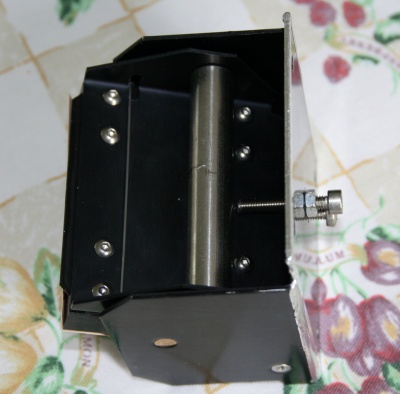MODIFICATION OF THE LHIRES III GRATING HOLDER TO EXTEND THE WAVELENGTH RANGE

This modification was prompted by the desire to monitor the KI 7669A line of epsilon Aurigae during the 2009-11 eclipse using the LHIRES III spectrograph at high resolution. Theoretically this should be possible using a 2400l/mm grating at an angle of 67.5 degrees. Unfortunately the adjustment mechanism on the LHIRES III restricts the grating angle to a maximum of about 62 degrees. (Note, even if the safety stop is removed, the required angle still cannot be reached due to the relative geometry of the micrometer and the bar it bears against.)
The solution was to add an adjustable stop to the grating holder above the original safety stop as shown. The new stop is directly above the existing stop, as close as possible while still allowing room for a locking nut. A second nut (not visible in this picture) is fixed with epoxy resin to the inside face of the grating holder.
In use, the original stop is screwed out and the grating angle approximately set using the adjustable stop. (Note the end of the screw will mark the grating backing plate. If you are concerned about this I suggest adding a plastic sleeve over the end of the screw.)
The holder is mounted in the spectrograph in the normal way with the micrometer adjuster fully withdrawn and final adjustments made to the wavelength setting using the adjustable stop. (The micrometer adjuster is not used) It is a good idea to make a note of the length of screw protruding to allow the wavelength to be reset at a later date. (A calibration graph could even be produced)
To use the grating holder as normal, swing the grating back round past the original safety stop, screw in the original stop and screw the adjustable stop out far enough so it cannot foul the standard adjustment mechanism.
Note the efficiency of the grating drops at high angles and CCD sensor sensitivity reduces in the IR so exposures can be significantly longer .